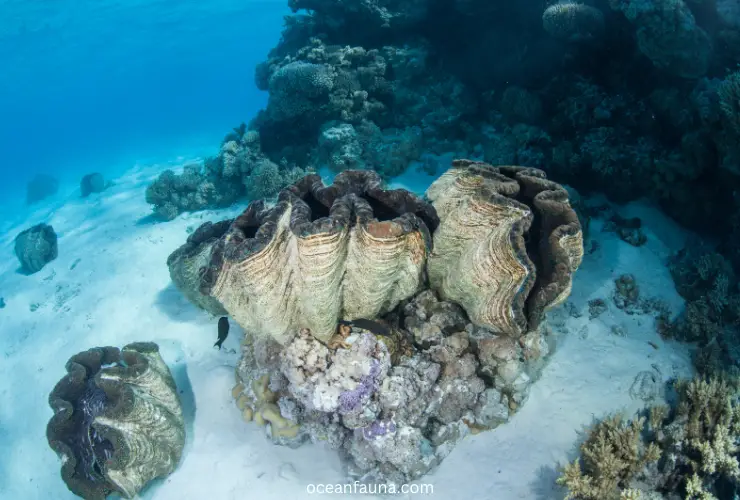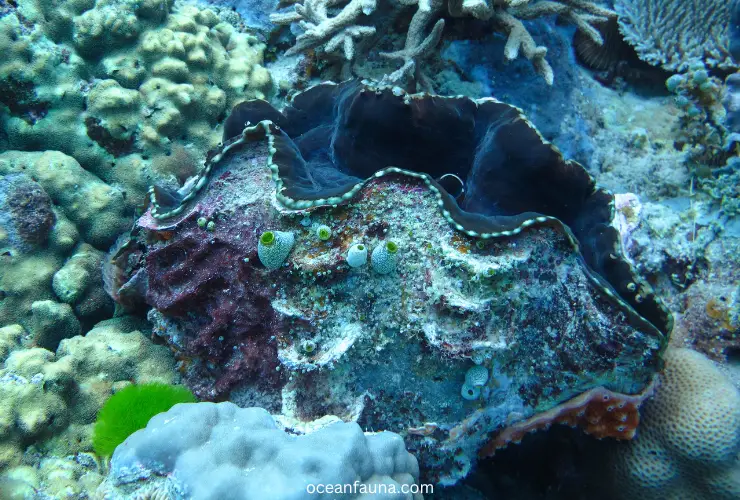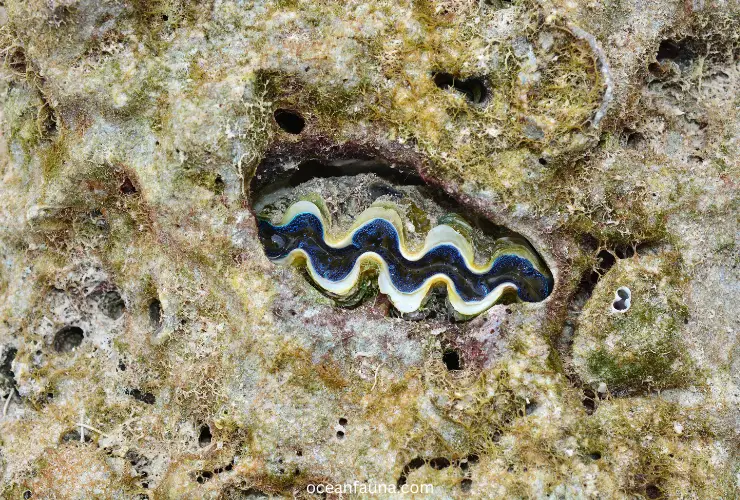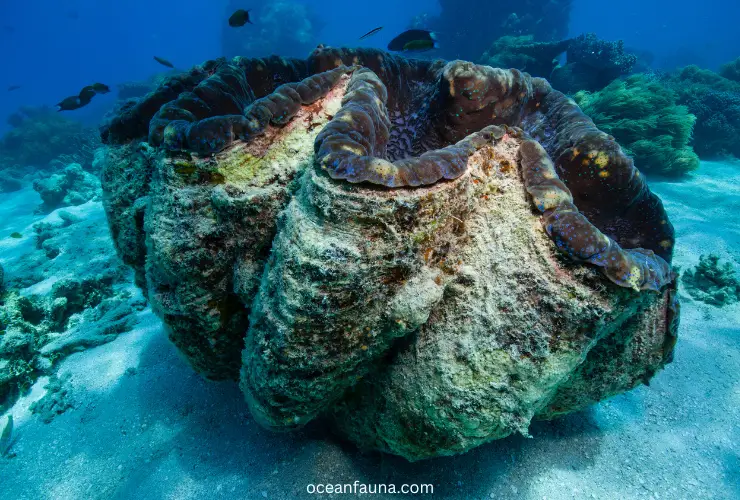Giant clam is the largest living mollusks. They can grow up to 4 feet long and weigh around 500 pounds! These massive creatures are seen in the warm waters of the Pacific and Indian Oceans.
These clams live on coral reefs and other shallow, tropical habitats. They play an integral role in their ecosystems by filtering water and providing a habitat for marine life.
Giant clams have colorful and patterned shells. These shells range from shades of blue and green to vibrant oranges and pinks. They have a soft, fleshy mantle that weighs over 100 pounds. It is covered in tiny, photosynthetic algae that help the clam produce its own food.
So, are you ready to learn more about these gigantic creatures? Let’s dive deeper into the world of giant clams and discover all the amazing things that make them unique.
About Giant Clam – A Quick Biology
Here’s a quick look at giant clam.
| Parameters | Details |
| Scientific name | Tridacna gigas |
| Kingdom | Animalia |
| Family | Cardiidae |
| Genus | Tridacna |
| Phylum | Mollusca |
| Class | Bivalvia |
| Order | Cardiida |
| Species | T. gigas |
| Habitat | Oceans |
| Life Span | 100 years |
| Diet | Algae, phytoplankton, nutrients in water |
| Geography | Indian and Pacific Oceans |

Geographic Distribution of Giant Clam
According to research, giant clams are found in tropical and subtropical regions, primarily in the Indo-Pacific Ocean.
Their distribution spans from the East African coast to the Pitcairn Islands in the eastern Pacific. They are also found from Okinawa to the south of the Great Barrier Reef in Australia.
They have been seen in many places around the Solomon Islands, including southern Malaita, eastern Guadalcanal, Ysabel, and eastern New Georgia. People have also reported seeing it in other areas like
- Western New Georgia
- Shortlands
- Gela
- Rennell
- Wagina
- Temotu
- Choiseul
- Sikaiana
- Ontong Java
- Russell Islands
Habitat and Range – Where Do Giant Clams Live?
Giant clams require a suitable environment to survive, including warm and clear nutrient-rich waters. They prefer shallow waters, where they can get plenty of sunlight to feed their photosynthetic algae. They are usually found in waters less than 20 meters deep.
Giant clams also occupy coral reef habitats and thrive in areas with low turbulence. They are most commonly embedded in sandy substrates or coral rubble. They also prefer habitats with high calcium carbonate levels, a mineral that helps their shells grow.

Appearance of Giant Clam
According to ACIAR, the giant clam (Tridacna gigas) is massive, ranging from 4 to 4.6 feet long and weighing around 500 pounds. Most of the giant clam’s weight is in its shell, with only about 10% in its soft parts.
These incredible creatures are not only impressively large but also have a striking appearance that makes them stand out in their underwater habitat.
One of the most distinctive features of a giant clam is its shell. The shell comprises two halves (bivalves) connected by a hinge, allowing the clam to open and close its shell as needed.
The shell can be in various colors, including blue, green, brown, and even pink. It can be patterned with stripes or spots. The shell is also covered with tiny bumps and ridges that give it a rough texture.
But the giant clam’s inside is even more impressive than the outside. Its soft, fleshy mantle is covered in tiny, photosynthetic algae, giving the clam vibrant colors. It usually has brown or green colors with blue, green, and gold stripes.
The blue radiance comes from special cells called iridophores in the mantle, which reflect and scatter light. The mantle also has pale spots called “windows” that let light in.
It is also adorned with tentacles that it uses to filter water for food. The giant clam also has a large, muscular foot that it can use to anchor itself in place or move around its habitat.
Behavioral Adaptations of Giant Clam
According to the Marine Biology, “Giant clams are filter feeders in their natural habitat.”
It means they use their tentacles to filter tiny particles from the water. Their large mantle is moved by tiny hairs called cilia. This creates a flow of water that brings food into the clam’s body.
Interestingly, giant clams can recognize and respond to changes in the amount and quality of food available in their environment. They can adjust the size of their siphons, which are the tubes through which they filter water, to maximize their feeding efficiency.
Adult clams are permanently stationary. They are anchored to a specific location and cannot move. So, how do giant clams defend themselves from predators?
Giant clams can quickly close their shells when threatened. They do this by contracting the powerful muscles that hold their shells together, creating a force strong enough to trap a predator. This reflexive behavior is triggered by touch or vibrations and occurs in less than a second.
Another interesting anti-predator behavior of giant clams is their ability to modify their color and pattern to blend in with their surroundings.
The clam’s mantle tissue contains pigments that change color depending on the amount of light and the clam’s surroundings. The clam can become less visible to predators by changing its color and pattern.
The mantle is a physical barrier between its soft body and predators. It contains stinging cells called nematocysts, which deter predators by causing pain or irritation.

Feeding/Diet – How Do Giant Clams Survive?
The giant clam’s diet consists of microscopic algae, known as “phytoplankton,” that float in the water. The clam opens its shell slightly to allow water to flow in, then filters out tiny algae with its mantle. This process is called “filter feeding.”
In addition to phytoplankton, giant clams feed on other small organisms, such as zooplankton and bacteria suspended in the water. Sometimes they also consume organic debris and detritus falling on the ocean floor.
Giant clams also have a symbiotic relationship with algae known as “zooxanthellae.” The algae live inside the clam’s tissues and use sunlight to produce sugars through photosynthesis. The clam then receives these sugars as food. At the same time, clams provide algae with nutrients and a place to live.
Reproduction of Giant Clam
Giant clams are protandrous hermaphrodites. They have both male and female reproductive organs and can produce eggs and sperm. They rarely self-fertilize. Most fertilization occurs externally, with eggs and sperm released into the water.
Giant clams reach sexual maturity around 4 to 5 years of age and can live up to 100 years. They spawn once or twice a year, usually during the full moon in the summer, when the water temperature is warmest and the tides are highest.
During spawning, giant clams release around 500 million eggs and sperms into the water. Gametes are synchronized within a population, with all individuals releasing eggs and sperm at the same time.
This increases the likelihood of successful fertilization, as the high concentration of gametes in the water makes it easier for them to find each other.
Growth of Giant Clam
Once fertilized, the eggs develop into planktonic larvae that drift with the current for several weeks. The larvae undergo developmental stages and eventually metamorphose into juvenile clams.
Once juvenile clams grow large enough, they settle on the ocean floor. They will attach themselves to a suitable substrate, such as rock or coral. They will then develop and mature into adult giant clams.
It is important to note that zooxanthellae do not pass from parents’ giant clams to their offspring. Instead, juvenile clams get them from their environment, specifically the water around them, when they are young.
Predators (Who Eats Giant Clam?)
Various predators prey on giant clams, including octopuses, crabs, starfish, and some fish.
Though giant clams close their shells tightly to protect their soft bodies, these predators have developed ways to get inside the shell and enjoy the meat.
Sea turtles, for example, have powerful jaws that crush clams. Octopuses use their strong arms to pry open shells, while some fish have specialized teeth that help them grind through clam shells.
Human Usage of Giant Clam
Humans have used giant clams for various purposes throughout history.
- Food: They are considered a delicacy in some cultures and are eaten in soups, sushi, and stir-fried dishes.
- Jewelry and decoration: Their shells are often used to make jewelry, home decor, and other decorative items.
- Aquarium trade: They are famous in the aquarium trade due to their colorful shells and unique appearance.
Threats on Giant Clam
Unfortunately, giant clams face many threats to their habitat, including overfishing and coral reef destruction due to climate change. They have been endangered or even extinct in some areas due to these threats. The IUCN has classified giant clams under the “vulnerable” species list.
The Role of Giant Clams in the Coral Reef Ecosystem
Giant clams play a vital role in coral reef ecosystems. They help maintain a healthy balance in the reef by filtering the water and removing excess nutrients that can harm other marine life.
Additionally, their shells provide shelter and a place to attach small organisms like algae and sponges.
How Do Giant Clams Adapt to the Coral Reef?
Giant clams have adapted to live in coral reef ecosystems in several ways. Their colorful shells blend with the surrounding coral, helping them avoid predators. They live in a symbiotic relationship with algae that provide them with energy.
Furthermore, giant clams have an innate ability to detect light and shadow, which helps them regulate the amount of sunlight they receive.
They can close their shells if they sense too much light, protecting themselves and the algae within them from damage.
Are Giant Clams Man-Eaters?
No, giant clams are not man-eaters. While they can reach large sizes and cause injury to humans who mishandle them, they are not aggressive toward humans. They do not actively seek out humans as prey.
Can You Eat Giant Clams?
Giant clams are a delicacy in some cultures. They are consumed, particularly in Southeast Asia and the Pacific Islands. The adductor muscles are the main part of the clam consumed. They are often prepared by grilling, steaming, or baking. However, their mantle is also eaten in some regions.

FAQs
What is a Giant Clam Shell Made of?
A giant clam shell is made of calcium carbonate, the same material as other clam shells and the shells of many other marine animals. People use their shells for various purposes, including crafting tools and decorative objects.
Is Giant Clam Safe to Eat?
Giant clams are safe to eat if consumed in small amounts and cooked correctly. However, like all shellfish, they pose risks when consumed.
One of the main risks when eating shellfish is that they can sometimes have harmful bacteria or toxins. Giant clams can store toxins like ciguatoxin, which can cause severe sickness and even danger to humans. (Source)
Do Giant Clams Make Giant Pearls?
Giant clams can produce pearls, but they are not the same as the famous huge pearls you may have heard about. Their pearls are not as large as oyster pearls. They are typically small and not very valuable in the jewelry industry.
In addition, giant clams do not make pearls often. When they do, it’s usually because of irritation or injury to the mantle. The mantle secretes a substance called nacre to protect itself, forming a pearl over time.
What is the Biggest Giant Clam Ever Found?
The biggest giant clam ever found is more than 4.5 feet (1.3 meters) wide and weighs about 550 pounds (250 kilograms).
Do Giant Clams Still Exist?
Yes, giant clams still exist today! However, their populations have declined due to overfishing, habitat loss, and pollution. However, conservation efforts are made to protect them. In some areas, they are bred in captivity and released back into the wild.
Do Giant Clams Have Eyes?
Giant clams do not have eyes, unlike humans. However, they have a simple sensory organ called a “mantle eye.” This mantle eye is located on the mantle. It cannot form an image like a human eye, but it can detect changes in light and dark and help the clam respond to its environment.
Conclusion
The giant clam is a remarkable creature that stands out from other marine animals due to its striking appearance. Its vibrant shell and flesh mantle are indeed a wonder to behold.
Additionally, its unique ability to generate food and secure itself in one spot makes it an invaluable member of the coral reef ecosystem.
Despite their enormous size, giant clams are filter feeders and pose no threat to humans. But these animals are threatened because we are taking too many from the ocean and ruining where they live. So, it’s super important that we do what we can to protect and save them.


1 thought on “Giant Clam: Habitat, Anatomy, Diet & Other Facts”